The Perfect Bra Size? - Start With the Underband, Not the Cups!
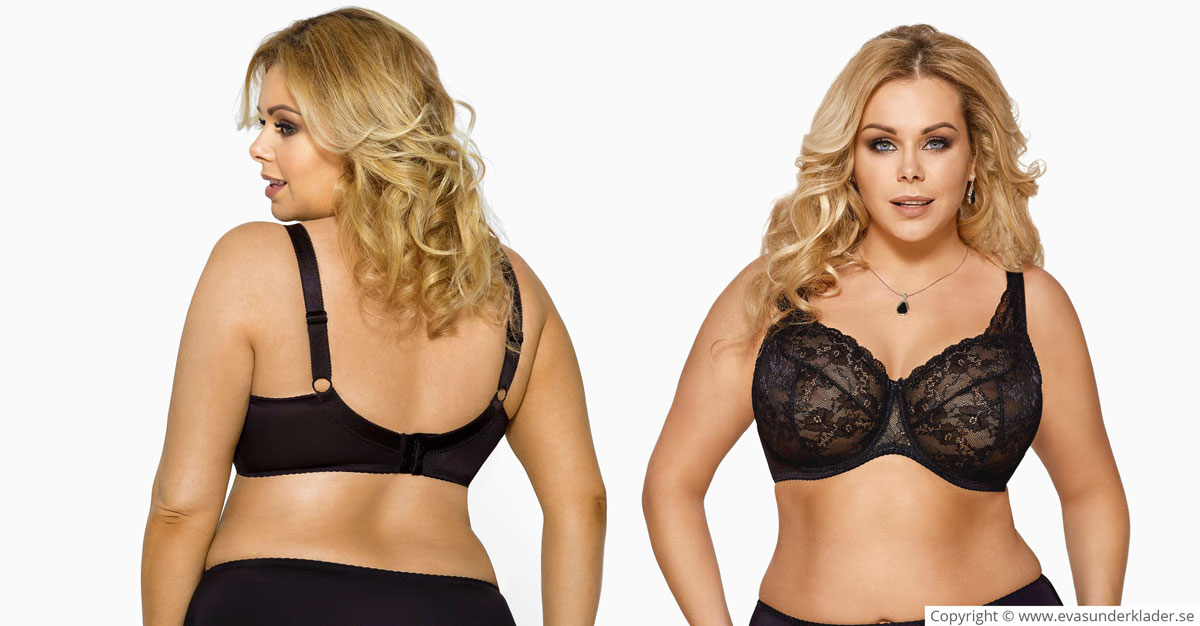
Choosing cup size first is a mistake. When shopping for bras, always start with finding a snuggly fitting underband. Contrary to popular belief, it's the size of the underband that dictates which cups size you should choose. Ignoring this step is precisely the reason why so man women struggle with discomfort.
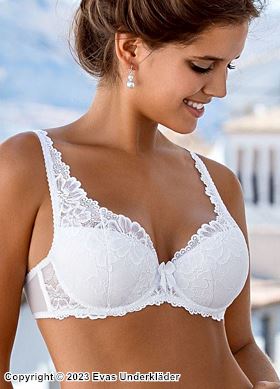 |
Best bra for most women. Beautiful and comfortable balconette bra. Non-itchy lace. A to I-cup. Shop here » |
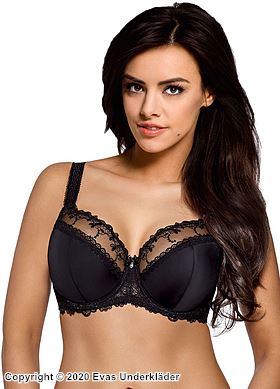 | Best bra for big bust. Full cup. Great support. B to L-cup. Shop here » |
This is part 1 of our series about bra sizes. Part 2 is about bra cup sizes.
In this comprehensive guide you will learn the basic and advanced methods to measure your size and understanding how a bra should fit. By the end of this article you will know what you have been doing wrong and how to correct sizing problems going forward.
Table Of Contents
- Misconceptions and beliefs about bra sizes that you need to abandon
- Why should you care about a correct bra size anyway?
- What is a bra size?
- Stop obsessing with bra cup sizes! The cup size is a wrong starting point
- Measuring under or above the bust? - Let's settle this once and for all!
- Under bust measurement - your first step in selecting a bra band
- Tight or loose? - How to measure and choose the correct bra band size
- TABLES: Under bust measurement to bra band size conversion
- The bra band should support and lift, not pinch
- How do I know if my bra band is too small?
- Which row of the hooks should the bra fit on?
- How do I avoid rolls on the sides and back?
- Okay, now I'm an expert on bra band sizes. What's the next step?
Misconceptions and beliefs about bra sizes that you need to abandon
Buying "the same bra size that I've always had" is among the worst things you can do. Most people are wrong about what bra sizes mean and how they work. There is a lot of buzz about "bra fitting", i.e., professional help to find the correct bra size. This guide will give you a much better understanding of bra sizes. It will bring you one step closer to becoming your own "bra fitter." Take your time, read this article, and save it for later. It will be worth it!
Why should you care about a correct bra size anyway?
A correct bra size is about protecting your shoulders, your back and getting a better posture. A proper bra size also makes your bust and figure look more appealing! Determining the bra band size is the first and most crucial step in finding the perfect bra size! This is especially true if you have a larger bust. Without a correct band size, finding the perfect bra is impossible.
Many women are "convinced" that they know how bra sizes work, even though they are entirely wrong. Chances are that you are of them. Most women have surprisingly limited knowledge about bra sizes. This leads to incorrect bra size choices.
This text will probably contain something that goes against your (often firm) beliefs. This is why we urge you to be a bit open minded when reading this article. =)
We will be talking about measurements and sizes. By measurement, we mean the dimensions of your body, e.g., that you have "31 inches" or "78 cm" around your chest. By size we mean a size designation, e.g. bra size "32B" or "75C".
What is a bra size?
A bra size ALWAYS consists of numbers and letters, e.g. 30DD, 36B and 42C or 70E, 85B and 95C. The numbers represent the size of the bra band (the part of the bra that goes around your body). The letters represent the size of the bra cups.
Bra size charts across the world - It's a bit messy!
Different countries and regions use different length units and size charts "standards." These are often stated together with the size, e.g. "UK 30B", "US 36B" or "EU 70E". US and UK charts are based on inches (1in ≈ 2.5 cm) and are identical in terms of bra band size. (There are some differences in cup sizes, but they are not crucial for this article.) Most of the rest of the world uses EU (European) sizes, also known as International. EU sizes are based on centimeters (1cm ≈ 0.4 in). US, UK, and EU sizes are the most commonly used. The remaining are FR/BE/ES, IT, AU/NZ, and JP/KO. Bra labels often show several or all of these.
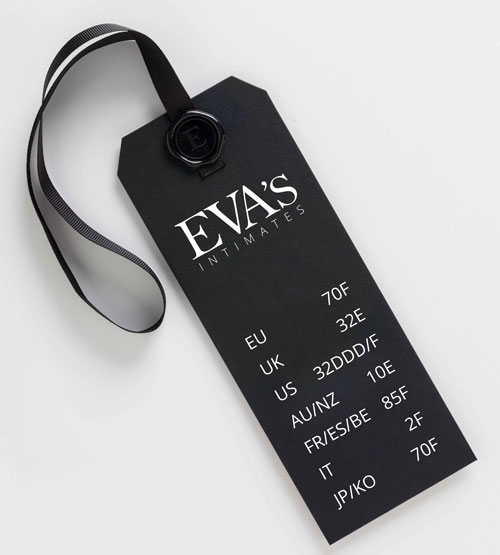
For the sake of simplicity, we will only be talking about US and EU bra sizes in this article. However, the principles apply to all bra size charts.
Clothes sizes such as "S", "M", "L", "XL" etc are not suitable for real bras. They are usually only found on apparel such as tops that look like bras but do not provide the same quality support that a real bra does. If a bra does not have a real bra size, then it's not a real bra. Some exceptions can be made for sports bras and swimwear. But even in these cases, such products are still preferred with real bra sizes.
Stop obsessing with bra cup sizes! The cup size is a wrong starting point
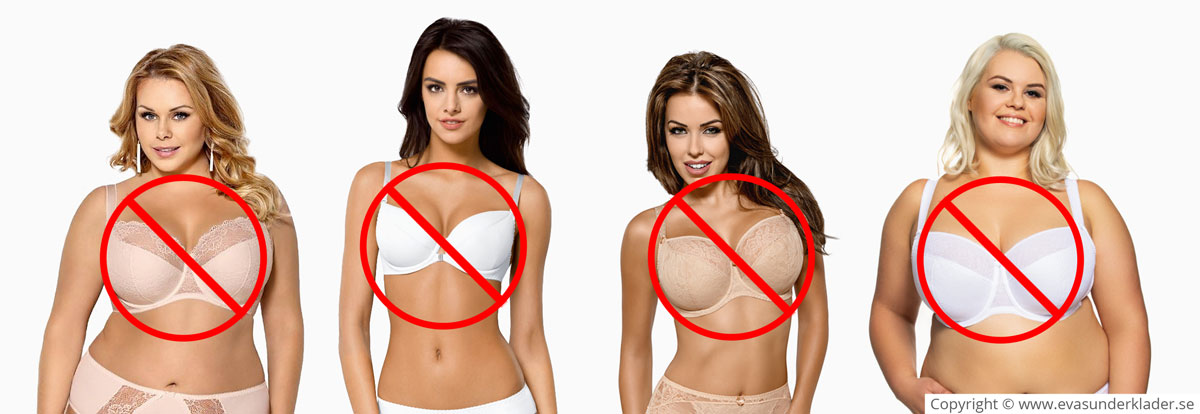
Most people think of bra sizes from the perspective of the bra cup size, e.g., "I have a C-cup" or "I have an E-cup." This is completely wrong! You need to stop focusing on the cup size if you want to find a bra that fits you really well! Bra cup sizes do not state the volume of the cups. The cup size states how large the cup is in relation to the band size. (Talking about bra cup sizes alone is like saying "I am 90% tall". 90% of what?)
A bra cup size means nothing without the bra band size. A
Measuring under or above the bust? - Let's settle this once and for all!
There is no single, accepted standard that tells which part of the torso should be measured to determine band size. But there are two competing alternatives:
- Measuring around the torso, immediately under the bust;
- Measuring around the torso, immediately above the bust, under the armpits.
(Don't confuse "above bust" with "over bust". "Over bust" refers to themeasurement around the torso including around the biggest part of the bust.)
Neither under or above bust measurement is more "accurate." Usually, these measurements will not be the same. As a rule of thumb, it is said that above bust is around 4 in / 10 cm larger than under bust. US / UK bra band sizes (30, 32, 34, etc) refer to the above bust measurement in inches. EU bra band sizes (70, 75, 80, etc) refer to the under bust measurement in centimeters.
It's challenging to measure above bust by yourself and do it correctly unless your arms and hands are very flexible. Usually, people end up measuring at an angle which ruins the measurement.
Measuring under bust is much easier. So much easier, in fact, that it's usually done for US bra band sizes too, even though US band sizes refer to above bust. A classic principle for US / UK bra sizes says "measure under bust and add 4 inches". (Please note that this principle does NOT apply to EU sizes as EU sizes refer to under bust measurements.)
In this guide, we will solely focus on under bust measurements. All tables will clearly show under bust measurements and corresponding US and EU bra band size. Don't worry about "adding 4 inches". We have taken this into account. Just focus on the actual measurement. Your actual measurement will show you the appropriate size.
Under bust measurement - your first step in selecting a bra band
Always start with determining the bra band size. Never start with trying to determine the cup size. As we described above, the cup size depends on the band size and can only be determined later. The choice of bra band size is based on the circumference around the body, immediately below the bust where the bust meets the chest. I.e., not across the bust nor around the waist.
Different body types affect and how they affect measuring

How is your body where the circumference is measured (under the bust and around the back)? Is the body slim and maybe even bony or is the body soft with more adipose tissue? Adipose tissue can behave differently. It can be "hard" and firm, but it can also be softer and with a higher tendency to yield to pressure. These characteristics are very important. They affect which bra band size is the most suitable for you. They are the reason why it's not possible to estimate bra sizes by merely looking at your own or somebody else's body. These characteristics also explain why a more full-figured woman can have the same or even smaller bra band size than a slim, athletic woman.
Tight or loose? - How to measure and choose the correct bra band size
Now you know where on the body the measuring is done, and the different properties bodies can have. So, how do you decide which bra band size is the correct one for you? Most people have not had a bra fitting done and will probably never have it either. However, you can get very far on your own with a tape measure.
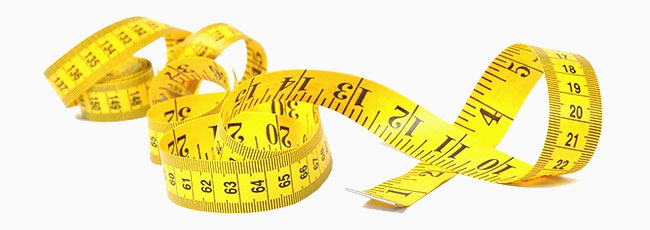
Using a measuring tape, measure the circumference around the body, directly under the bust where the bust meets the chest. Measure without wearing a bra. (You can measure while wearing a bra, but it has its own set of challenges. In this guide, we measure without wearing a bra.) The tape measure must be at the same height at the front as at the back of your body, i.e. horizontal. If you measure askew, your measurement will be wrong!
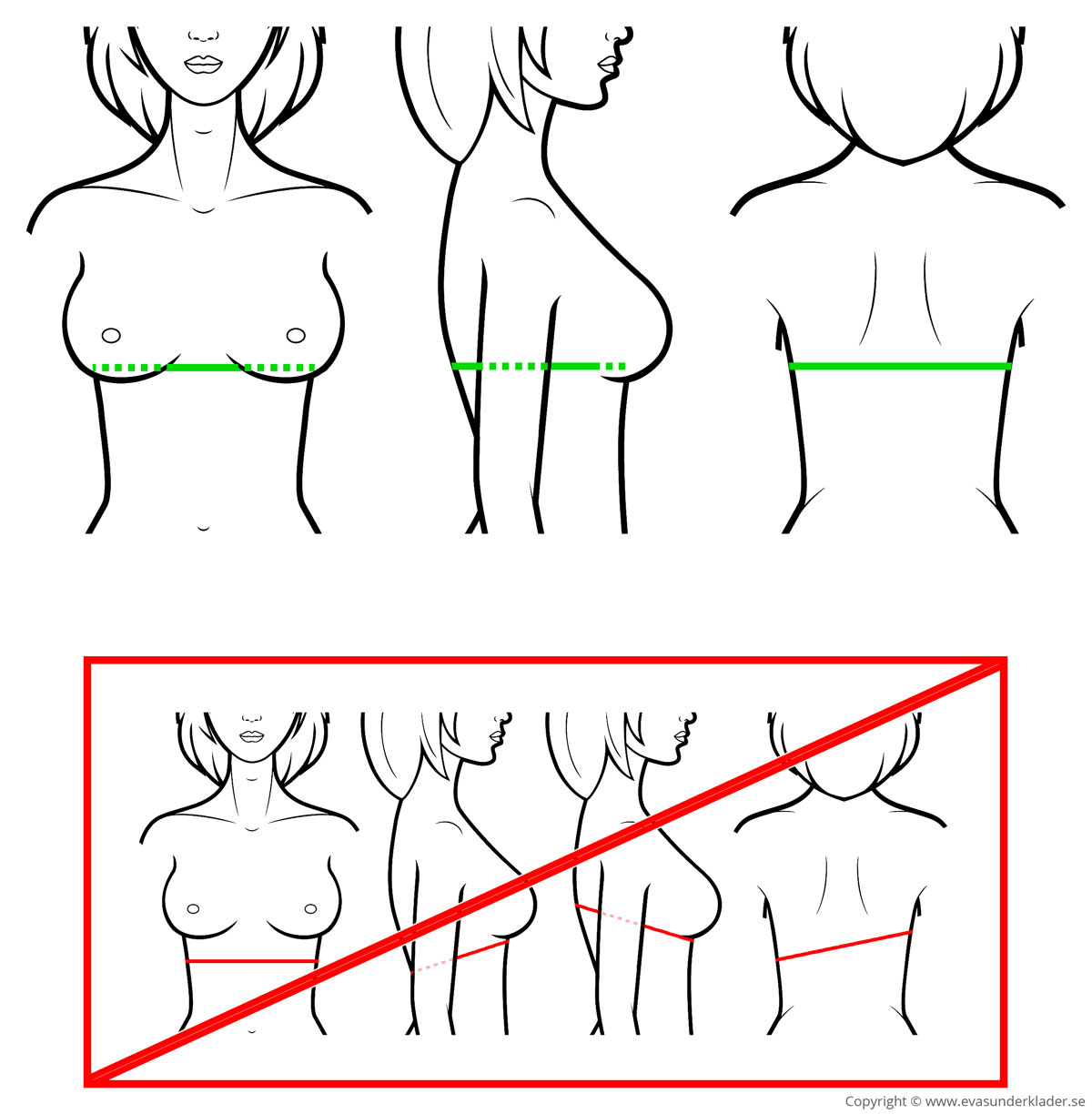
Do NOT hold the tape measure loosely against the skin. The tape measure must be tightened slightly to feel firm and snug against the body. This is important! This step, that is, the tightening, is about "digging through" the soft body tissues that easily yield to pressure. (Imagine how a belt works and how it is tightened to be functional, this is a similar situation.) Tighten the tape measure so that you get through the soft tissues but not so much that it hurts. Tighten the tape measure so that it feels "firm" against the body but not so that it feels like the air is being squeezed out of you. Do not hold your breath when measuring but do not exaggerate either by forcing all the air out of your lungs. Write down your measurement. (Many tape measures show both centimeters and inches. Choose the one that is the standard in your country. Make sure you use the same measurement scale throughout this guide.)
The standard approach is to round your measurement down to the nearest band size. ALWAYS round your measurement down!
US / UK sizes - Rounding and choosing the final band size
US bra band sizes come in steps of two: 30, 32, 34, etc. For US / UK bra band size, round your under bust measurement down to the nearest even number and then add 4 inches. The resulting number is your US bra band size. Scroll down to se our table.
E.g., if your measurement is 31.5 in then round down to 30 in. However, "30" is NOT your band size. As mentioned before, US bra band sizes refer to above bust measurements. But we are measuring under bust. Compensate for this by adding 4. This gives us: 30 + 4 = 34. The resulting US bra band size is 34.
EU / Intl. sizes - Rounding and choosing the final band size
EU (a.k.a International) bra band sizes come in steps of five: 70, 75, 80 etc. For EU / Intl. bra band size, round your under bust measurement down to the nearest 5 or 10. The resulting number is your EU bra band size.
E.g., if your measurement is 89cm then round down to 85cm. The resulting EU bra band size 85.
Rounding down a bit more
If you know that you have particularly soft body tissue, then you can try to go down one additional size. This is a typical recommendation for women having measurements over 40 in or 90 cm. This approach might not be suitable for individuals sensitive to pressure. All these recommendations aim to ensure that the bra band fits firmly enough.
TABLES: Under bust measurement to bra band size conversion
| US / UK bra band sizes Under bust measurement (snug fit as described) |
||
| (Inches) If you have measurement: |
(Centimeters) If you have measurement: |
Choose US / UK bra band size: |
| 24-25.5 in | 60-64 cm | 28 |
| 26-27.5 in | 65-69 cm | 30 |
| 28-29.5 in | 70-74 cm | 32 |
| 30-31.5 in | 75-79 cm | 34 |
| 32-33.5 in | 80-84 cm | 36 |
| 34-35.5 in | 85-89 cm | 38 |
| 36-37.5 in | 90-94 cm | 40 |
| 38-39.5 in | 95-99 cm | 42 |
| 40-41.5 in | 100-104 cm | 44 |
| 42-43.5 in | 105-109 cm | 46 |
| 44-45.5 in | 110-114 cm | 48 |
| 46-47.5 in | 115-119 cm | 50 |
| 48-49.5 in | 120-124 cm | 52 |
| 50-51.5 in | 125-129 cm | 54 |
| 52-53.5 in | 130-134 cm | 56 |
| 54-55.5 in | 135-139 cm | 58 |
| 56-57.5 in | 140-144 cm | 60 |
| 58-59.5 in | 145-149 cm | 62 |
| 60-61.5 in | 150-154 cm | 64 |
| EU / Intl. bra band sizes Under bust measurement (snug fit as described) |
||
| (Centimeters) If you have measurement: |
(Inches) If you have measurement: |
Choose EU / Intl. bra band size: |
| 60-64 cm | 24-25.5 in | 60 |
| 65-69 cm | 26-27.5 in | 65 |
| 70-74 cm | 28-29.5 in | 70 |
| 75-79 cm | 30-31.5 in | 75 |
| 80-84 cm | 32-33.5 in | 80 |
| 85-89 cm | 34-35.5 in | 85 |
| 90-94 cm | 36-37.5 in | 90 |
| 95-99 cm | 38-39.5 in | 95 |
| 100-104 cm | 40-41.5 in | 100 |
| 105-109 cm | 42-43.5 in | 105 |
| 110-114 cm | 44-45.5 in | 110 |
| 115-119 cm | 46-47.5 in | 115 |
| 120-124 cm | 48-49.5 in | 120 |
| 125-129 cm | 50-51.5 in | 125 |
| 130-134 cm | 52-53.5 in | 130 |
| 135-139 cm | 54-55.5 in | 135 |
| 140-144 cm | 56-57.5 in | 140 |
| 145-149 cm | 58-59.5 in | 145 |
| 150-154 cm | 60-61.5 in | 150 |
Are these absolute rules that always apply and without exception? Unfortunately, not! However, these guidelines are an excellent starting point. Each body is different. Our bodies also change, both periodically (e.g., by hormones that regulated the menstrual cycle) and due to, well, life as it progresses.
The bra band should support and lift, not pinch
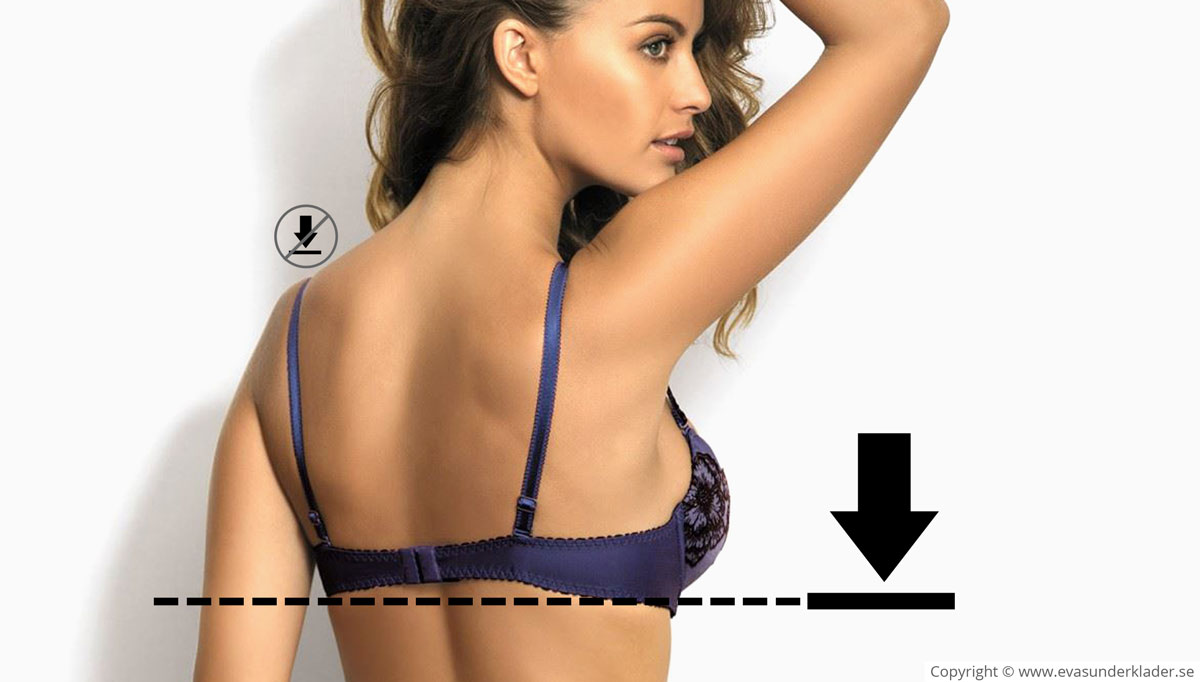
Why should the bra and fit snug and tight? And why do you have to tighten the tape measure when measuring under the bust? The purpose is, of course, not to make you uncomfortable. It's the bra band, NOT the shoulder straps, that should be doing most of the supporting and lifting of your bust. If the bra band is too loose, the bust will be held up by the shoulder straps instead.
Allowing your shoulder straps to do most of the lifting is a big mistake! If you are lucky, the bra will be more uncomfortable than it should. If you are unlucky, it will lead to shoulder and back problems such as bad posture, pain, headaches, and even migraines. The onset of these problems will be slow, and so will the recovery. Many women having these problems never suspect their bras being the cause. Women will often vigorously defend their bra size choices. The most common defense? "I have always worn this bra size."
As discussed before, your body yields to pressure to some degree. Also, bras are somewhat elastic. They must be so they can "follow" our bodies when we breathe in and out. The tape measure that we use to measure ourselves, on the other hand, is not elastic. It does not stretch. These are the reasons why it's vital that the measurement is done snugly and tightly and that the result is rounded down to the nearest bra band size.
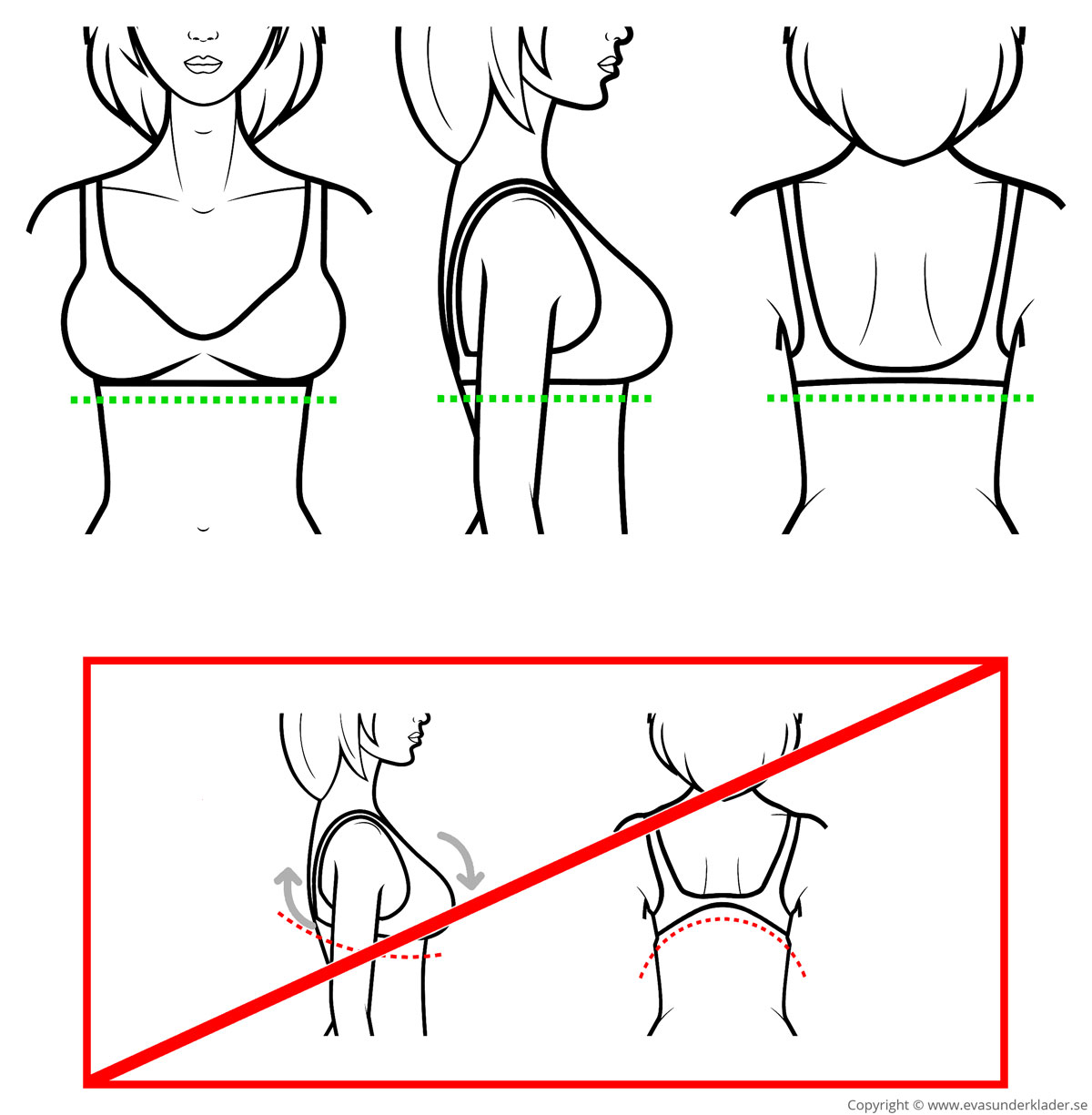
When you wear a bra, the bra band should fit tightly enough so that the front and back are at about the same level. Another way to explain is that your bra should not "rotate forward." Is the back of the bra pulled up and does it create an arc upwards? It's a classic sign of the bra band being too big. If the bra band is not sufficiently tight and snug, then the weight of the bust will be transferred to the shoulder straps instead. When this happens, the shoulder straps will pull the bra band from the back, i.e., the back straps in the back are pulled up. This is the "rotation" mentioned earlier. Your shoulders will suffer. A lot! If the shoulder straps "dig" or even "cut" into your shoulders, it's often due to a too big bra band.
This rule is also a bit flexible. Some bras are not made be straight at the bottom. Some bras are intentionally designed so that its bra band bends like a bow or take on some other shapes. In these cases, we can't expect the bottom of the bra band to be perfectly straight around our body. Use the product picture as guidance to understand how the bra is meant to be worn.
How much is the bra band allowed to deviate from a straight line? A bra with a correct bra band size can crawl up 1 in or 2 cm at the back, but preferably not more than 1.5-2 in or 3-5 cm. The bra band has the function of "anchoring" the bra to the body. If the bra band can move too easily, then the anchorage is not sufficiently firm and sturdy. When the bra band is not sturdy enough, most women will compensate by tightening the shoulder straps. Unfortunately, this compensation will not lift the bust. Instead, the bust will stay in the same place while the bra band at the back will crawl up even more. The whole bra will "rotate" forward. Neither comfortable nor pretty.
How do I know if my bra band is too small?
Because our bodies have different degrees of softness. Determining whether the bra band is too small is something that you can feel rather than see. (This is why we are a bit reluctant to show images as examples.) If the bra band (not the shoulder straps) is so tight that you constantly feel uncomfortable and if you always look forward to taking it off, then it's a good sign that the bra band in your bra is too small.
Signs that your bra has a too small bra band
- It is difficult to close the hooks without some serious pulling.
- The bra band stretches so much and is so tense that it seems like it might break.
- The elastic dig and "cut" into the skin resulting in pain. (The bra band, not the shoulder straps.)
- You feel like you can't breathe freely.
- The bra band seems to be "pulling down" towards the waist. (This happens because the waist is often narrower than the chest.)
Too small bra cups - a VERY common mistake
Too small bra cups are often mistaken for too small bra band! If the bra cups are too small, then the bust will push the entire bra forward. This, in turn, may feel like the bra band on the back is too tight. In other words, the symptom and the cause are located in different places and can easily fool us. This issue is especially common for people who have just started using a smaller bra band size. Remember that if you change bra band size, you will most likely need to change the bra cup size as well. Use our conversion table that shows how these changes should be made. The table has conversions for bra band sizes US 24-50 and EU 60 to 150, and bra cup sizes A to S-cup.
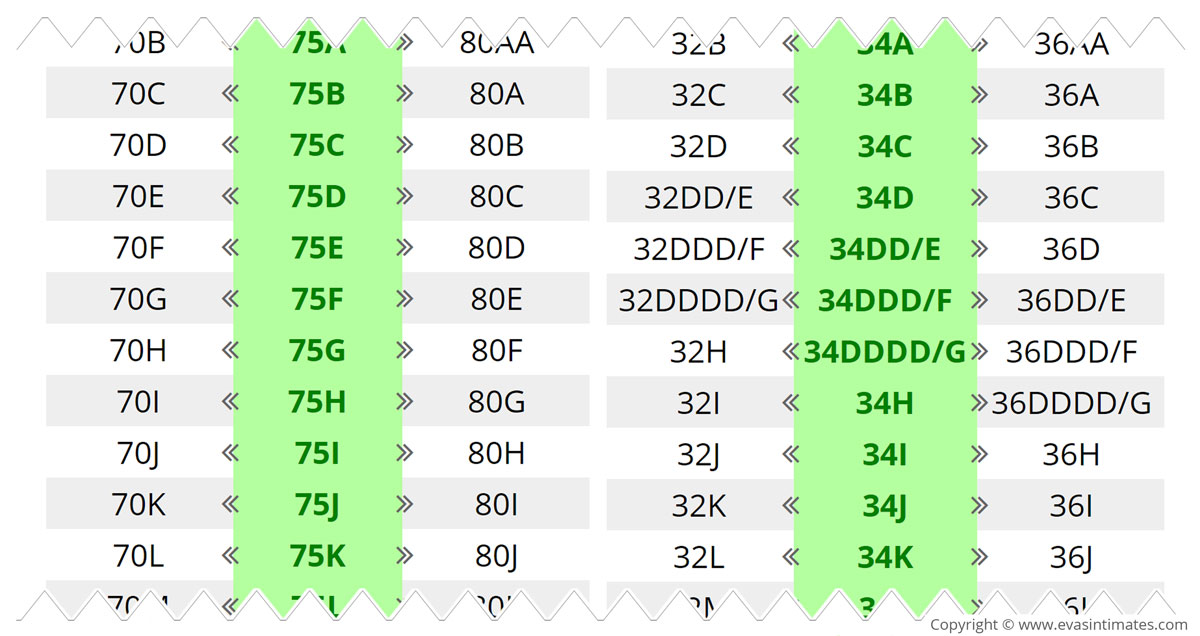
You can test whether it's the bra cups or the bra band that is too small. Do the following: Put on your bra backward, so that the bra cups end up on your back. The hook and eye closure will now be on your front, directly under your bust. Now your bust should not have an impact on the bra band tightness. If the bra band still feels too tight, then change to a larger bra band size. However, if the bra band feels more comfortable now or even a bit loose, then it's a sign that it's the bra cups that are too small and not the bra band. It's worth noting that there are band extensions available.
Does the bra band still feel "just wrong"?
If the bra band doesn't create any of the issues we listed before but if you still feel uncomfortable, it might merely be a matter of habit. Chances are that you have been using bras with incorrect bra size most of your life. Maybe you are not used to how a well-fitting bra actually feels. This is quite common if you have a fuller bust, where the bra band is generally larger, stronger and more noticeable.
We suggest that you wear the bra for a while to see if you get used to it. You might stop noticing the bra band after a while or, if you have a bigger bust, at least notice it less. (Does all this feel a bit awkward? Compare this with a snug, elastic collar. The collar will definitely not strangle you, but it can still feel uncomfortable or distracting at first.)
Which row of the hooks should the bra fit on?
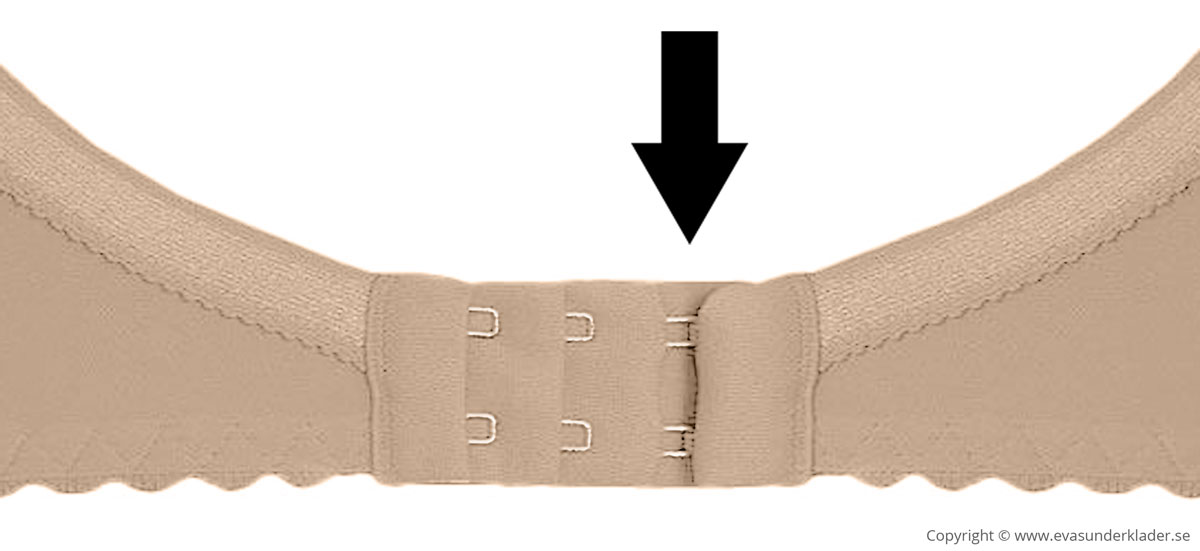
Each bra and each bra band will stretch slightly and lose some of its original shape. This happens to all clothes. The more you use your bra, the more it will stretch out. When you buy a new bra, you should try to choose a bra that fits you on the outermost hooks. When the bra gets stretched over time, you can "counteract" this stretch by moving to the inner hooks. So, getting a bra that fits on outermost hooks is only a matter of extending the lifetime of the bra.
Our guide is based on this approach and philosophy. But, if your body size fluctuates a lot, then it could be better to choose bras that fit on the middle hooks. You can, of course, buy a new bra that fits on the innermost hooks but be aware that you won't be able to use it for a long time unless your size increases.
How do I avoid rolls on the sides and back?
Avoiding rolls is perhaps the biggest reason why women keep choosing too large bra band sizes. A common misconception is that a "correct bra band size does not create rolls". Additionally, rolls are seen as unflattering and many women choose aesthetics over comfort.
A properly selected bra size with snug and firm bra band usually does not create more or larger rolls than a too loose bra band. A loosely fitted bra band will be pulled upwards on the back. (By the shoulders straps as described before.) A loose bra band will create rolls anyway, sometimes in other places and often larger. It will sometimes take a while. But as you start moving then so will the bra band and the rolls will appear. If you want to avoid rolls, then a correct, tight bra band is always better.
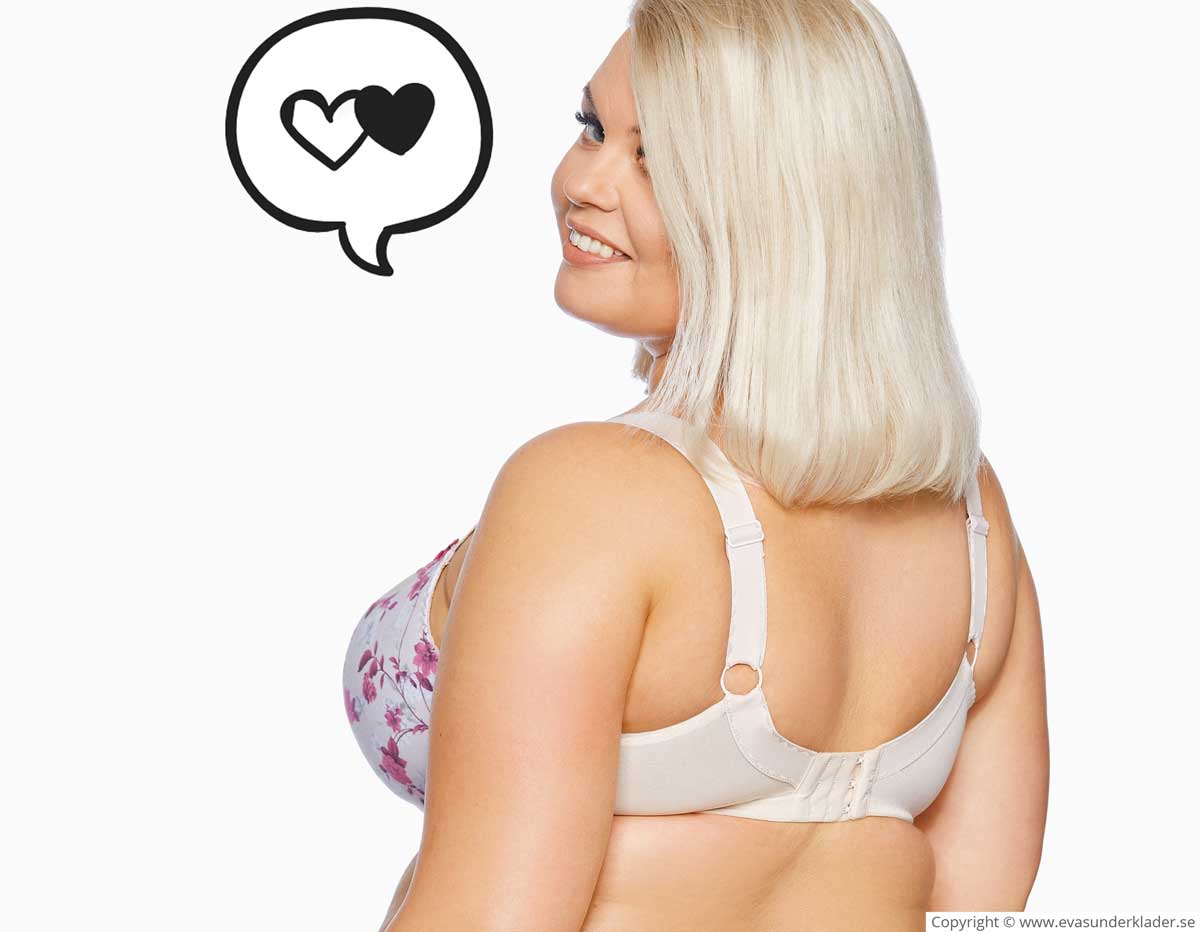
Do you want a comfortable bra that really fits your body? Then accept that a correct bra band size that will provide real support can result in rolls. Our bodies are soft. We are built in layers, harder and softer. For your bra to be able to stay firmly in place, a certain amount of tightening is necessary. You are not a wooden doll. Rolls are natural. Accept and learn to love your rolls! =)
Rolls from bra bands are created due to pressure. If you still want to reduce rolls, then one way is to choose bras with a vertically wider bra band. A vertically wider bra band distributes the pressure from the bra band over a larger surface. This leads to a smaller tendency for rolls to be formed. Bikini tops are an opposite example of this. Their "bra bands" are usually just a string that will inevitably dig deep into the body.
Okay, now I'm an expert on bra band sizes. What's the next step?
You now know much more about bra sizes and bra bands than most women. You have learned why the bra band is crucial in the pursuit of a perfect bra size. And you know how to choose a correct bra band size.
So, what is the next step? Cups! Bra cups deserve an article of their own (coming soon). In short, people tend to make the opposite mistake about bra cup sizes than with band sizes. Bra bands need to fit firmly. Bra cups, on the other hand, should hold the bust with little to no tightness. The majority of women choose too small bra cups. They compensate for this by choosing too large bra band sizes. Why? Because they start with selecting bra cups size instead of bra band size!
If you are about to change bra band size, please remember to adapt the bra cup size accordingly. Use our conversion table. It's very easy to use and contains conversions for bra band sizes US 24-50 and EU 60 to 150, and bra cup sizes A to S-cup.
Did you find this article helpful? Spread this knowledge! Help your friends and family to get rid of sore shoulders, back pain, and poor posture. You will be doing them a favor! =)